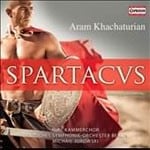Spartacus
(Spartakus) (1950-54, rev.1960/68)Libretto by Nikolai Volkov
SATB Chorus
3(III=picc).2.corA.3(III=bcl).asax.2-4.4.3.1-timp.perc:tgl/2wdbl/2tom-t/tamb/smSD/SD/BD/cyms/tamt/t.bells/church bells/tubaphone/glsp/xyl-2hp-pft-cel-str
Abbreviations (PDF)
VAAP
Ever since being used as the theme tune to BBC TV’s The Onedin Line, the Adagio from Spartacus – originally danced by the hero and his wife Phrygia – has been an international hit and the single best-known number of the ballet. But how many people know the original full ballet score, scored for a large orchestra and chorus? And how much more powerful that Adagio is when heard in context!
For, unlike Gayaneh, Spartacus is not merely a ballet of dance ‘numbers’, but Khachaturian’s most ambitious stage work, in which he emulated the symphonic style of the best ballets of Tchaikovsky and Prokofieff (particularly of Romeo and Juliet). That said, the entire score is probably best heard accompanying the ballet itself. In concert, highlights from the ballet are often programmed, including four orchestral suites selected by the composers and scenes taking the form of symphonic pictures. A particular favourite – apart from the Adagio – is the sequence in Act II when the Roman general, Crassus, takes decadent pleasure in his slave girls’ dancing, culminating in one of the most powerful numbers Dance of the Gaditanian Maidens and Spartacus’s Victory.
Note by Daniel Jaffé

Deutsches Symphonie-Orchester Berlin/Michail Jurowski
Capriccio 10 817-18
Buy this CD from Amazon
